Examining US Paper Currency
Posted by KYN Praha in Chronology on Tuesday, July 10, 2012
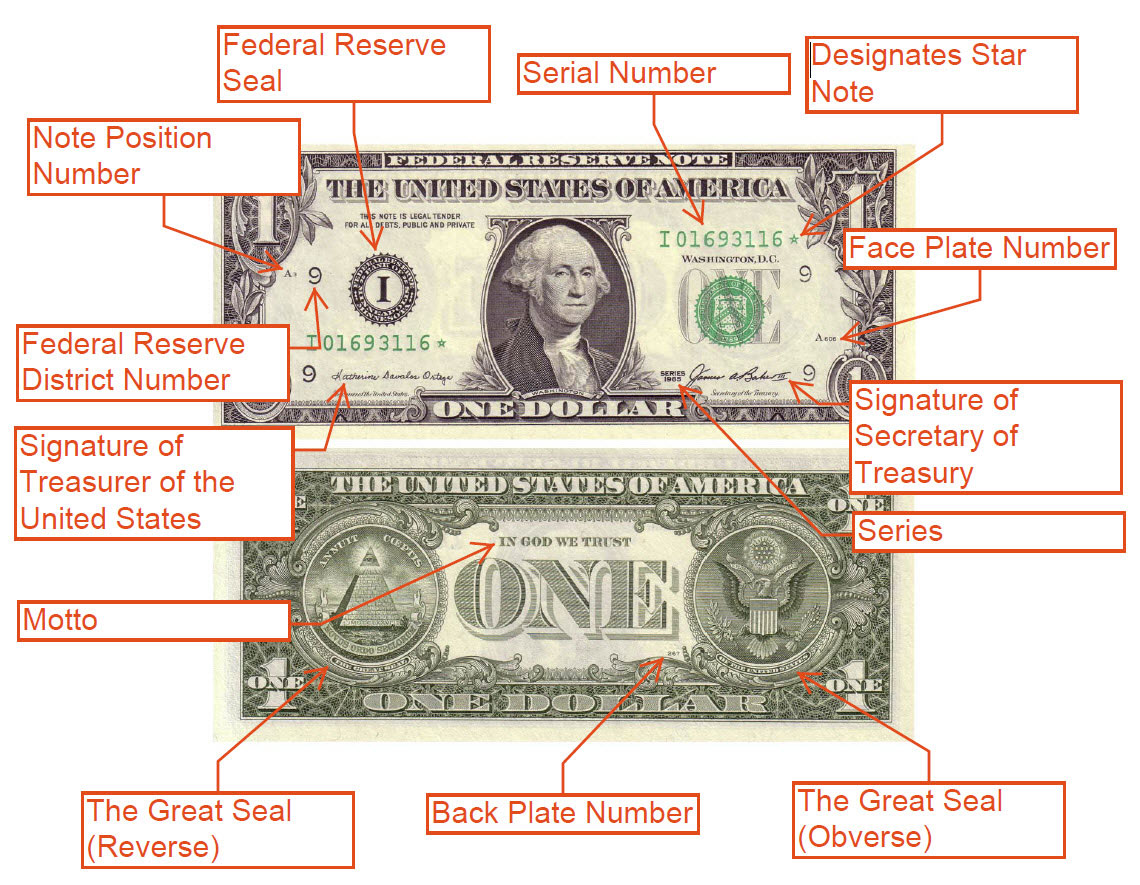
The Federal Reserve Seal and the Federal Reserve District Number —
There are twelve different Federal Reserve Banks responsible for
printing paper money in the United States. On the one dollar bill, the
bank can be quickly identified by a letter code in the Federal Reserve Seal
to the left of the portrait of George Washington. The letter code is
also found in the prefix of the serial number. A corresponding Federal
Reserve District Number code is found in four locations.
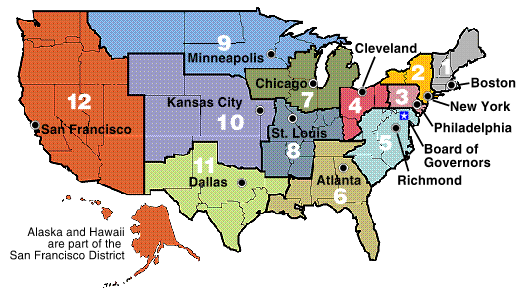
Only Federal Reserve Notes have the Federal Reserve Seal. Other notes
(Gold Ceritificates, Silver Certificates, US Notes, and National Notes)
were not issued by the Federal Reserve.
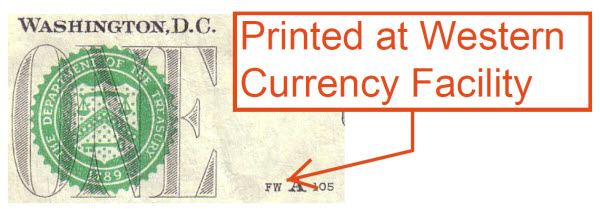
Note Position Number — The Note Number Position appears in the upper left quadrant. It is a letter number combination that indicates which position on the plate the note was printed. The number indicates the quadrant and the letter indicates the position within the quadrant. The sheet of currency below indicates the note positions.
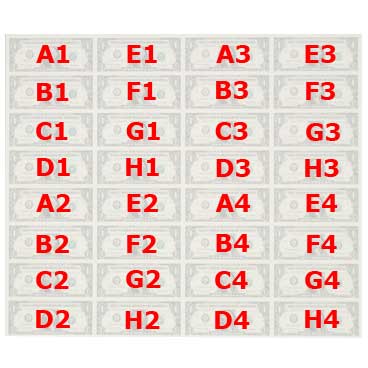 Motto — The Motto,
"In God We Trust", first appeared on US coins in 1864. It wasn't until a
law was passed in 1955 mandating that the motto be printed on US paper
currency. It was first printed in 1957 on $1 Silver Certificates, 1935G series year,
and it was gradually phased in on other denominations and classes and
is now printed on the back of all US paper currency of the series year 1963B or later.
Motto — The Motto,
"In God We Trust", first appeared on US coins in 1864. It wasn't until a
law was passed in 1955 mandating that the motto be printed on US paper
currency. It was first printed in 1957 on $1 Silver Certificates, 1935G series year,
and it was gradually phased in on other denominations and classes and
is now printed on the back of all US paper currency of the series year 1963B or later.
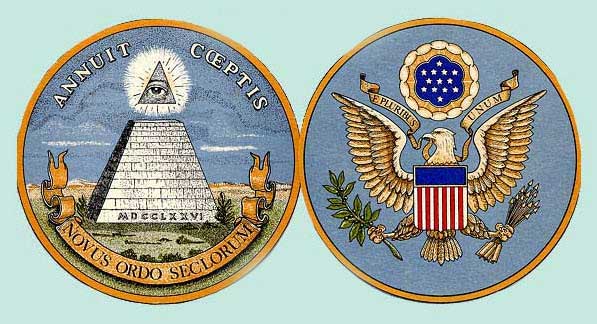
On the reverse of the seal is a pyramid with 1776 in Roman numerals at the base. The pyramid stands for permanence and strength. The pyramid is unfinished, signifying the United States' future growth and goal of perfection. The western side of the pyramid is dark because we had not yet begun to explore the Western United States. A sunburst and an eye are above the pyramid, representing the overseeing eye of a deity. The 13-letter motto, "Annuit Coeptis" means "He has favored our undertakings." Below the pyramid the motto, "Novus Ordo Seclorum" means "A new order of the ages," standing for the new American era.

Serial Number — The serial number of a bill appears twice, once
in the lower left hand quadrant and again in the upper right hand
quadrant on the front of the bill. The letter which precedes the numbers
must be the same number that identifies the Federal Reserve Bank. The
last letter of the serial number or suffix letter identifies the number
of times that the Bureau of Engraving and Printing used the sequence of
serial numbers — A is the first time, B is the second time, C is the
third time, etc. Sometimes the prefix or suffix letter is replaced by a
star. (See Star below). With one run for each letter of the
alphabet (26) and 32 bills per run, there are a total of 832 bills per
serial number.
Star — When a note which bears a serial number is mutilated in
the course of manufacture, it must be replaced in the series to ensure a
proper count of the notes produced. To print another note with an
identical serial number would be costly and time-consuming.
Consequently, a "star note" is substituted. This note has a serial
number which is out of sequence with the others in the series. A star is
printed after the number to show that it was placed in the series as a
substitute.
Series Date (or Series Year)
— In the lower right quadrant between the portrait of George Washington
and signature of the Secretary of the Treasury is the Series Date. This
number is presented as a the year portion of a date — as in 2004 — and
sometimes has a letter suffix — as in 2004A. It is important to note
that there is not a series for every calendar year. A new series will
result from a change in the Secretary of the Treasury, the Treasurer of
the United States, and/or a change to the note's appearance such as a
new currency design.
- Design Change — New series year (e.g. 1999).
- New Secretary of the Treasury — New series year (e.g. 1999).
- New Treasurer of the United States — A suffix letter is added to the current series year (e.g. 1999A).
Plate Number — The Face Plate Number (also called check number)
is printed on front of the bill in the lower right quadrant above the
Federal Reserve District Number. The Back Plate Number is printed on the
back in the lower right corner. Plate Numbers identify the plate from
which the note was printed. Changes in plate numbers often creat Mule Notes.
FW — A small "FW" in the lower right corner on the front of the
bill next to the face plate number indicates that the bill was printed
at the Bureau of Engraving and Printing's Western Currency Facility in Fort Worth, Texas.

Note Position Number — The Note Number Position appears in the upper left quadrant. It is a letter number combination that indicates which position on the plate the note was printed. The number indicates the quadrant and the letter indicates the position within the quadrant. The sheet of currency below indicates the note positions.

The Great Seal of the United States — The First Continental
Congress requested that Benjamin Franklin and a group of men come up
with a Seal. It took them four years to accomplish this task and another
two years to get it approved. The front (or obverse) of the seal shows
an American bald eagle behind the national shield. In the right talon,
the eagle holds an olive branch which symbolizes peace, with 13 berries
and 13 leaves. In the left talon, the eagle holds 13 arrows, which
represents war. The 13 leaves represent the original colonies. The
eagle's head is turned toward the olive branch, showing a desire for
peace.
The top of the shield represents the Congress, the head of the eagle the
Executive branch, and the nine tail feathers the Judiciary branch of US
government. The 13-letter motto, "E Pluribus Unum," on the ribbon held
in the eagle's beak means "Out of Many, One."

On the reverse of the seal is a pyramid with 1776 in Roman numerals at the base. The pyramid stands for permanence and strength. The pyramid is unfinished, signifying the United States' future growth and goal of perfection. The western side of the pyramid is dark because we had not yet begun to explore the Western United States. A sunburst and an eye are above the pyramid, representing the overseeing eye of a deity. The 13-letter motto, "Annuit Coeptis" means "He has favored our undertakings." Below the pyramid the motto, "Novus Ordo Seclorum" means "A new order of the ages," standing for the new American era.
Sumber : http://www.panix.com/~clay/currency/note.html
This entry was posted on Tuesday, July 10, 2012 at 4:34:00 PM and is filed under Chronology. You can follow any responses to this entry through the RSS 2.0. You can leave a response.
- No comments yet.




